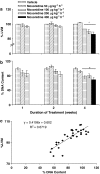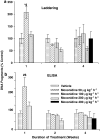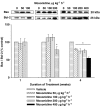Control of left ventricular mass by moxonidine involves reduced DNA synthesis and enhanced DNA fragmentation
- PMID: 18059325
- PMCID: PMC2241781
- DOI: 10.1038/sj.bjp.0707588
Control of left ventricular mass by moxonidine involves reduced DNA synthesis and enhanced DNA fragmentation
Abstract
Background and purpose: Left ventricular hypertrophy (LVH) is a maladaptive process associated with increased cardiovascular risk. Regression of LVH is associated with reduced complications of hypertension. Moxonidine is an antihypertensive imidazoline compound that reduces blood pressure primarily by central inhibition of sympathetic outflow and by direct actions on the heart to release atrial natriuretic peptide, a vasodilator and an antihypertrophic cardiac hormone. This study investigated the effect of moxonidine on LVH and the mechanisms involved in this effect.
Experimental approach: Spontaneously hypertensive rats were treated with several doses of moxonidine (s.c.) over 4 weeks. Blood pressure and heart rate were continuously monitored by telemetry. Body weight and water and food intake were measured weekly. Measurements also included left ventricular mass, DNA content, synthesis, fragmentation, and apoptotic/anti-apoptotic pathway proteins.
Key results: The decrease in mean arterial pressure stabilized at approximately -10 mm Hg after 1 week of treatment and thereafter. Compared to vehicle-treated rats (100%), left ventricular mass was dose- and time-dependently reduced by treatment. This reduction remained significantly lower after normalizing to body weight. Moxonidine reduced left ventricular DNA content and inhibited DNA synthesis. DNA fragmentation transiently, but significantly increased at 1 week of moxonidine treatment and was paralleled by elevated active caspase-3 protein. The highest dose significantly decreased the apoptotic protein Bax and all doses stimulated anti-apoptotic Bcl-2 after 4 weeks of treatment.
Conclusions and implications: These studies implicate the modulation of cardiac DNA dynamics in the control of left ventricular mass by moxonidine in a rat model of hypertension.
Figures






References
-
- Amador N, de Jesus Encarnacion J, Rodriguez L, Tello A, Lopez M, Guizar JM. Relationship between left ventricular mass and heart sympathetic activity in male obese subjects. Arch Med Res. 2004;35:411–415. - PubMed
-
- Amann K, Greber D, Gharehbaghi H, Wiest G, Lange B, Ganten U, et al. Effects of nifedipine and moxonidine on cardiac structure in spontaneously hypertensive rats. Stereological studies on myocytes, capillaries, arteries, and cardiac interstitium. Am J Hypertens. 1992;5:76–83. - PubMed
-
- Bisognano JD, Weinberger HD, Bohlmeyer TJ, Pende A, Raynolds MV, Sastravaha A, et al. Myocardial directed overexpression of the human beta(1)-adrenergic receptor in transgenic mice. J Mol Cell Cardiol. 2000;32:817–830. - PubMed
-
- Bobik A, Dilley R, Kanellakis P. Sympatho-adrenal mechanisms regulating cardiovascular hypertrophy in primary hypertension: a role for rilmenidine. J Hypertens. 1998;16:S51–S54. - PubMed
-
- Braz Nogueira J. Regression of left ventricular hypertrophy in hypertension—does it reduce cardiovascular risk. Rev Port Cardiol. 2005;24:1007–1013. - PubMed
Publication types
MeSH terms
Substances
LinkOut - more resources
Full Text Sources
Medical
Research Materials

